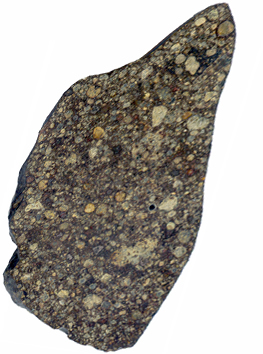Meteoroids, Meteors, and Meteorites
On a crisp, clear August evening, you can be treated to Nature's own "fireworks": every August 11th or 12th, the Perseid meteor shower delights sky watchers. Every 33 years or so, the Leonid meteors streak across the sky in unforgettable meteor storms. Meteors, meteoroids, and meteorites all tell different versions of a complex story that stretches back to the very beginning of the solar system.
Some Basic Terminology
| Meteoroids are the parent bodies that produce meteors. Meteoroids can consist of both icy (cometary) and rocky (asteroidal) material. Meteoroids are usually considered to be less than 100 m in diameter — larger bodies would more likely be classified as asteroids. This is just a distinction "of convenience" — there is no hard and fast division between meteoroids and asteroids. Meteoroids orbit the Sun in Earth-crossing orbits. |
| Meteors are the streaks of light that we see as meteoroids entering the atmosphere. There is no distinction made between cometary or asteroidal bodies at this point. The "meteor" is the flash of light that either body would create as it heats or ablates in the atmosphere. |
| Meteorites are the bodies that survive entry in the Earth's atmosphere. There are many sub-classifications of meteoritic material. |
Orbital and Physical Characteristics of Meteoroids and Meteors
|
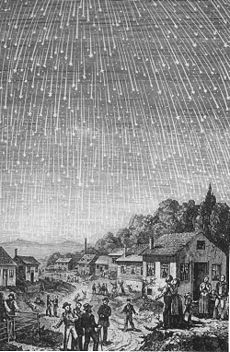 |
||||||||||||||||
| Figure 19.1: Woodcut of the famous Leonid meteor storm, November 1833. (Image in public domain) | |||||||||||||||||
Meteors, Meteor Showers, and Meteor Storms
The overwhelming majority of meteors are cometary in origin — they are just tiny specks of dust entering the Earth's atmosphere, and are completely vaporized in the atmosphere. We classify meteors as either Sporadic or Stream meteors based on their origin.
Figure 19.2 shows the orbit of Comet Halley in relation to the orbits of Mercury, Venus, and Earth. Twice a year Earth, passes close to the orbital path of Comet Halley, resulting in the Eta Aquariid and Orionid meteor showers.
If you would like to learn when meteor showers happen, please follow the "Take a closer look" link.
|
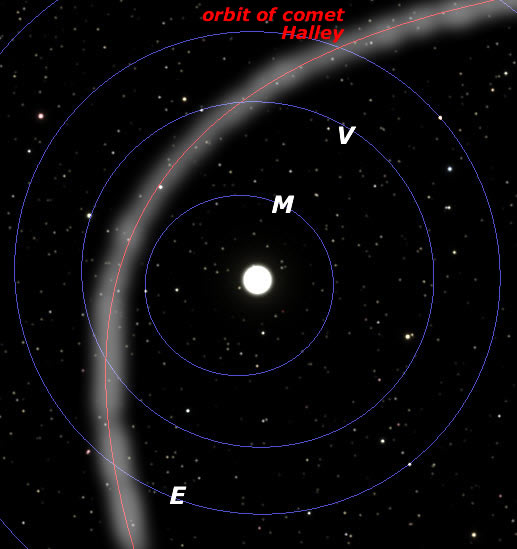 |
| Figure 19.2: The orbit of Comet Halley and depiction of the debris field left in the comet's wake. |
Bolides and Meteorites
Several times each year, newspaper headlines will report a brilliant "fireball" or bolide seen in the sky (Figure 19.3). These rare events are usually greeted with excitement by the astronomical community because they offer the possibility of actually recovering a meteorite.
| Figure 19.3: |
Despite their brilliance, most fireballs either to not survive entry or go unfound. The bright meteor captured in Figure 19.3 would most likely have vapourized before reaching the ground. So, finding an actual meteorite is a task that takes careful planning and good information. The Prairie Meteorite Search Program is designed to do just that. By coordinating all-sky cameras, such as the one used to produce the video in Figure 19.3, researchers are able to not only detect potential meteorite-producing events, but also gain detailed information about the trajectories of these objects. Even with this information, however, finding a meteorite is a difficult task!
What's So Special About Meteorites?
In many ways, meteorites are traveling laboratories that have the potential to tell us about the earliest epochs of the solar nebula. The term "meteorite" is broad, and can be further divided into a number of significant classes.
Iron meteorites Iron meteorites are dense with dark, rusted surfaces. They consist of iron-nickel alloys, and when sliced open, reveal the characteristic Widmanstätten pattern shown in Figure 19.4. This pattern is created by the crystal structure of iron-nickel alloys as they cool very slowly (a few degrees per million years!) . Stony meteorites Stony meteorites are composed of silicate compounds, and are very similar to Earth rocks. Figure 19.5 shows a small stony meteorite. Notice the conglomeration of many smaller rocks. Stony meteorites usually have a darkened outer heat or fusion crust created by ablation as they travel through the atmosphere. |
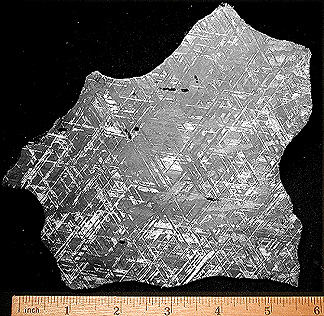 |
| Figure 19.4: The Widmanstätten pattern that helps identify an iron meteorite. (Image courtesy NASA) | |
Careful analysis of the chemical composition of meteorites tells us a great deal about the solar nebula. One identifying feature of chondrites are small, glassy beads, or chondrules. Chondrules are small bits of rock that suggest that molten material cooled quickly, and was incorporated into the meteoritic material. A very special (and rare) stony meteorite is the Carbonaceous Chondrite. These meteorites are rich in organic molecules, and are believed to represent the earliest "picture" of what material condensing from the solar nebula would be like. Some stony meteorites contain no chondrules, and these are called achondrites. Stony-iron meteorites Stony-iron meteorites contain iron, nickel, and stony material, but lack chondrules, organic materials, and do not display the Widmanstätten patterns seen in iron meteorites. |
|
| Figure 19.5: Rollover image of chondrite showing chondrules and fusion crust. |
Proportions of Meteorites
The meteorites that we find don't accurately reflect the true distribution of meteoritic types. Iron meteorites are much easier to find than stony or chondritic but they represent only a small fraction of the actual meteor events during a year. This is called a selection effect. The comparison of finds versus actual proportion of meteorite types is shown in Table 19.2.
| Type | Fall (%) | Find (%) |
| Iron | 6 | 50 |
| Sony-Iron | 1 | 5 |
| Stony | 93 | 45 |
| Table 19.2 Proportion of meteorite finds versus falls. | ||
Tagish Lake — A Recent Major Fall
About 8:30 in the morning on January 18, 2000, telephone calls lit up switchboards across the west coast of Yukon, Alaska, and northern British Columbia. A brilliant fireball traveling slowly southward was seen by thousands. Some reported a peculiar, burnt metallic odour in the air that lingered for hours, as well as an equally long-lived dust trail in the sky. This was a rare event, and with the wealth of data available, teams from University of Calgary and University of Western Ontario were able to recover large amounts of the fireball. By great fortune, the bolide struck the frozen surface of Tagish Lake in the Yukon. In Figure 19.6, Alan Hildebrand of the University of Calgary holds a block of ice in which a sample of the Tagish Lake meteorite can be seen.
| The Tagish Lake fall is one of the most significant falls in recent history. The meteorite collected is a carbonaceous chondrite. Note that Dr. Hildebrand is wearing rubber gloves to help prevent contamination of the sample. The sample of meteoritic material was also protected from contamination because was encased in the surface ice on Tagish Lak. This fortunate turn of events has provided astronomers with a rare opportunity to investigate possibly the most fragile of meteorites, which may be some of the first material to condense in the early solar system. | 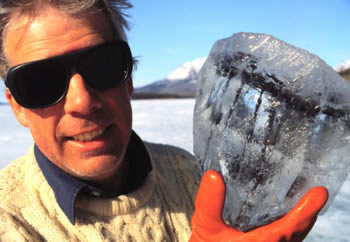 |
| Figure 19.6: Dr. Alan Hildebrand of the University of Calgary holds a piece of meteorite encased in ice on Tagish Lake. |
Example 19.1: A local farmer finds a curious rock while cultivating, and thinks it might be a meteorite. He contacts you (because of your vast knowledge of astronomy!). What are some of the things you would look for in assessing this potential find?
Solution: Consider the two broad family types: iron meteorites and stony meteorites.
If it is an iron-nickel meteorite, then it should:
- be much denser than a normal field rock.
- should shows signs of melting (smooth, dark surface, with lots of smaller indentations).
- be able to attract a magnet.
- show Widmanstätten patterns, if you could slice it open.
If the rock is a stony meteorite, it would be harder to identify, but it should:
- have a fusion crust.
- not be magnetic.
- show chondrules, if you could slice it open.
Regardless, if you are suspicious that this may be a meteorite, contact the nearest research university!
Rocks from Mars!
A few dozen of the meteorites discovered to date are known to have originated on Mars! Figure 19.7 shows a meteorite discovered in the Allan Hills, Antarctica, in December 1977. The location and date of discovery are reflected in the name ALHA 7705. By carefully measuring ratios of particular isotopes, we know that this rock has the same composition as Mars' crustal material, and is unlike other meteorites that most likely originated from asteroidal material. This meteorite is believed to have been delivered to Earth as a result of a massive impact event on Mars that ejected large amounts of rocky material into space. |
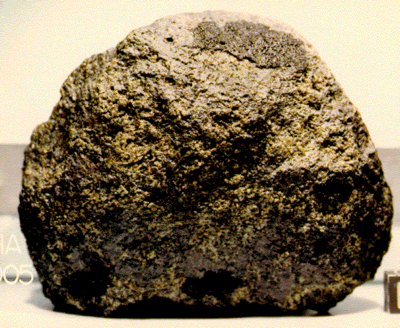 |
| Figure 19.7: Mars meteorite ALHA 7705. (Image courtesy Johnson Space Center) |
So, Where do Meteors and Meteorites Come From?
Most of the meteors that we see at night are cometary material that does not survive entry. The meteorites that we find are almost all either asteroidal or originating on other bodies (Mars, Moon, etc.), and delivered via impact events.

To understand the origin and characteristics of meteoroids, meteors, and meteorites, and to understand their place in the solar nebula theory.
Chp. 25.1
559- - 566

We take it for granted that meteors and meteorites are astronomical phenomena. During the 17th and 18th centuries, however, reports of rocks falling from the sky were greeted with skepticism. It was not until the French physicist Biot investigated a report of a major fall, and was able to bring back meteoritic samples, that the scientific community began to take seriously the view that meteorites were truly "rocks from the sky."

Diagrams like Figure 19.2 can be deceiving! This is a 2D projection of orbits that are not in the same plane. Earth's orbit does not have to intersect at two points along the orbit of Comet Halley. In general, the orbits do not cross, but are close enough for the debris of the comet to create a meteor shower.

Meteorites are rare — only about 24 000 have been collected and catalogued.

A popular misconception is that very bright meteors must have landed nearby. In fact, very few bright meteors survive entry, and the ones that do are seen by people scattered over hundreds of miles. Tracking and finding such a fall is a major undertaking.


Dr. Peter Brown (above) of the University of Western Ontario and Dr. Alan Hildebrand (below) of the University of Calgary are both internationally known experts on meteors and meteorites, and are co-leaders of the Prairie Meteorite Search program.

Antarctica is one of the best "meteorite hunting grounds." Meteorites stand out on the frozen snow mass, and can even be spotted from the air. The cold, dry environment also protects the meteorites from contamination.

